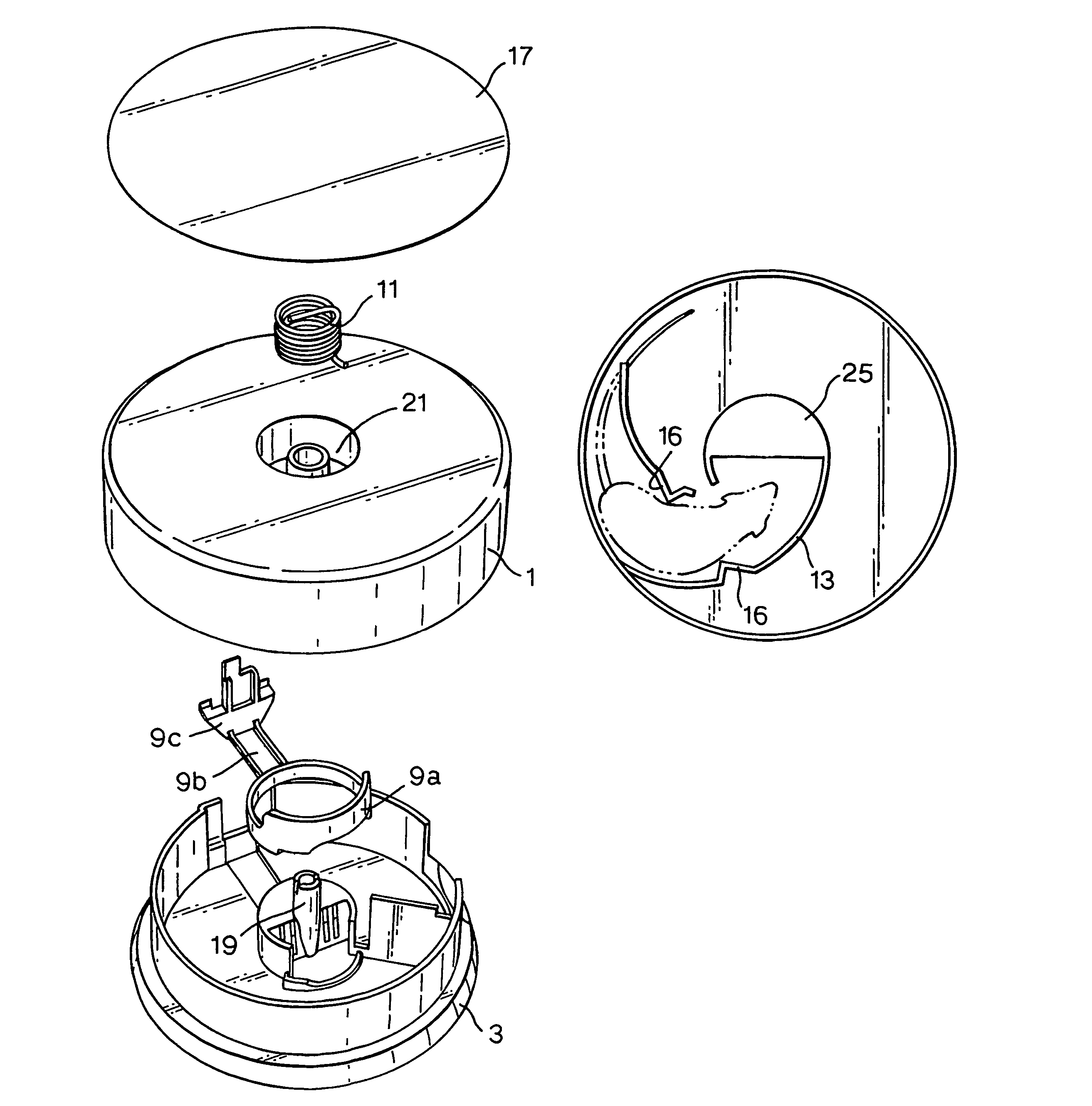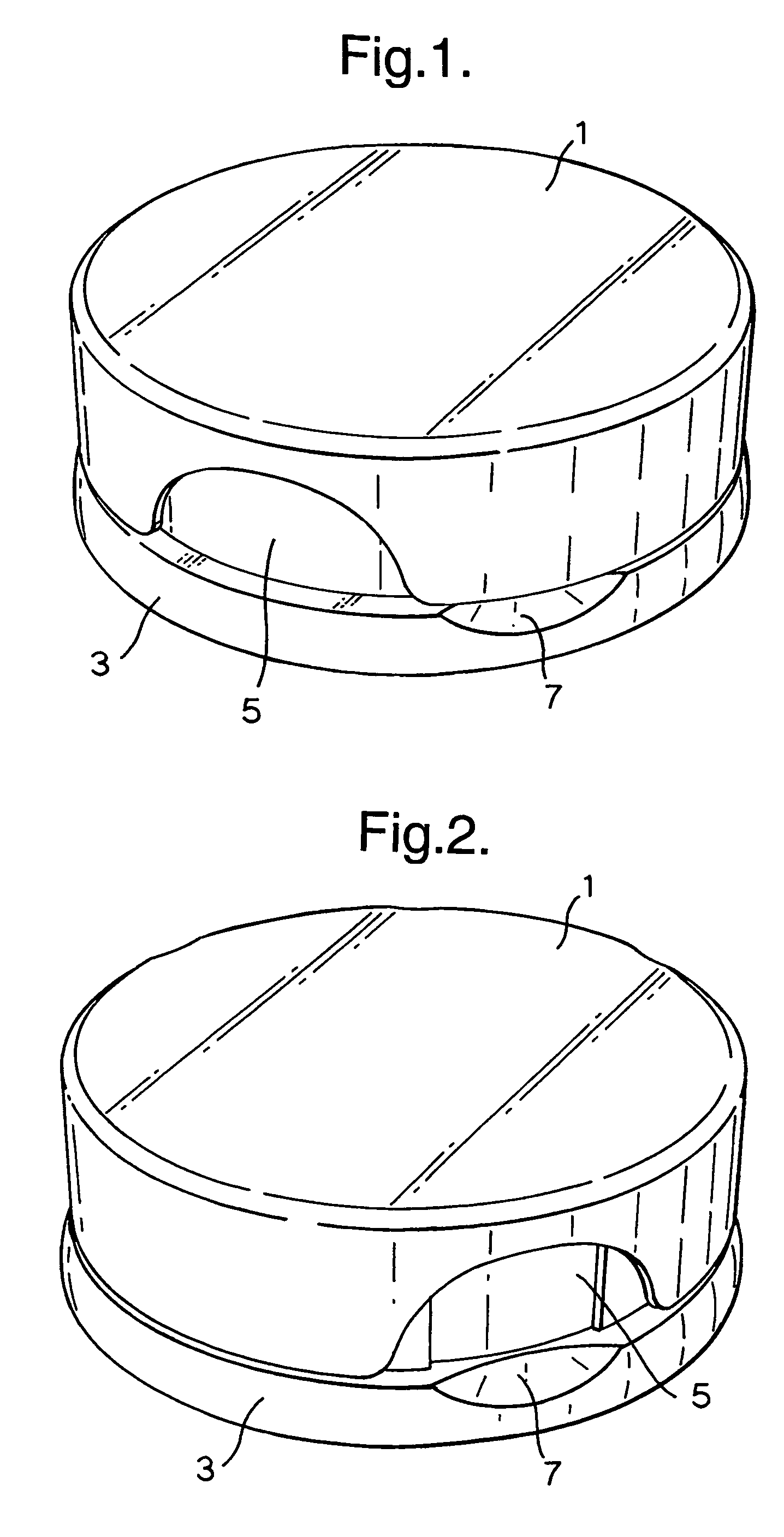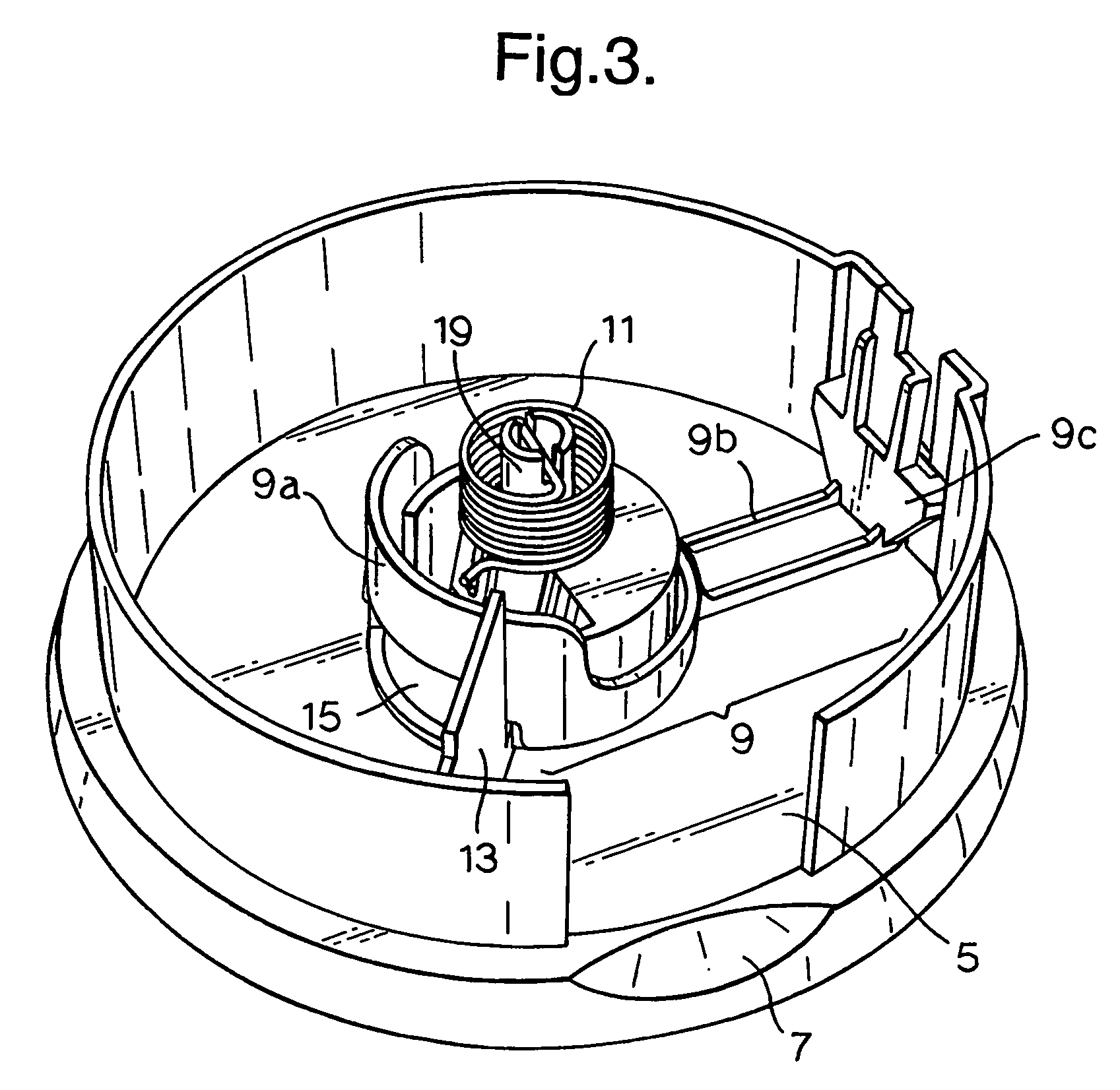[0006]The present invention provides a mousetrap comprising an enclosure comprised of at least a top, a base and a closable aperture; and a trigger mechanism comprising a lever arrangement connected to a biasing means, wherein the aperture, when open, is adapted to admit the mouse into the enclosure and when closed, the trapped mouse is substantially concealed within the enclosure, the mousetrap being set to trap the mouse by manual rotation of the top relative to the base to open the aperture which is held open against the force of the biasing means by engagement of the lever arrangement with a stop means, the mousetrap being activated to trap the mouse by the entry of the mouse into the enclosure causing the lever arrangement to disengage from the stop means thereby causing the top to contra-rotate relative to the base under the force of the biasing means so as to close the aperture, thereby trapping the mouse and substantially concealing the trapped mouse within the enclosure. As such, a mousetrap is provided that is self-closing following the trapping of a mouse. This self-closing feature is particularly desirable as this removes the exposure of the user, for example the homeowner, to the trapped mouse or the need for the user to close the mousetrap once a mouse has been trapped. The mousetrap according to this preferred embodiment is also advantageous as the user is able to readily determine when a mouse has been trapped without the need of actually observing the trapped mouse. A further associated advantage with the mousetraps according to the present invention is increased safety; that is, the enclosure surrounding the trap mechanism prevents, for example, a child or pet from inadvertently setting off the trap and causing possible injury, and also, children and pets are not exposed to trapped or dead mice that can be possible sources of disease.
[0007]Preferably, the mousetrap in accordance with a preferred embodiment of the invention further comprises a strike plate connected to the top that extends substantially at right angles to an internal wall of the enclosure such that upon rotation of the top relative to the base under the action of the biasing means, the strike plate rotates with the top and contacts the mouse. In this way, the mouse is contacted by the strike plate thereby incapacitating or killing the mouse. Preferably also, the mousetrap further comprises a catch plate connected to the base and extending substantially at right angles to an internal wall of the enclosure such that upon contra-rotation of the top relative to the base under the action of the biasing means, the strike plate rotates with the top and contacts the mouse to trap the mouse between the strike plate and the catch plate. As such, not only is the mouse struck by the strike plate upon contra-rotation of the top relative to the base, but it is subsequently squashed between the strike plate and the catch plate thereby increasing the effectiveness of the mousetrap to trap, incapacitate or kill the mouse. In a particularly preferred embodiment of the invention, the stop means may also serve as the strike plate, the strike plate being connected to the top and extending substantially at right angles to an internal wall of the enclosure such that upon contra-rotation of the top relative to the base under the action of the biasing means, the strike plate rotates with the top and contacts the mouse.
[0009]It is envisaged that the mousetrap in accordance with the present invention may be a single-use device (i.e disposable) wherein a user disposes of the mousetrap and the trapped mouse without the need to open the mousetrap and remove the mouse. The mousetrap in accordance with a preferred embodiment of the invention may, however, be reusable such that a user is able to remove and reset the mousetrap. In this regard, so as to assist in the removal of the dead mouse, the mousetrap is able to be disassembled. This feature also advantageously assists in the cleaning of the mousetrap after removal of a dead mouse prior to resetting the mousetrap.
[0012]It is envisaged that the mousetrap according to yet another preferred embodiment will further comprise a bait housing. Preferably, the bait housing is located in the centre of the enclosure. In this way, the mouse has to enter the maximum distance into the mousetrap enclosure before activating the trap. This ensures that the mouse is fully enclosed within the enclosure before trap occurs, thereby substantially concealing all parts of the trapped mouse from external view. Preferably also, the bait housing is able to be loaded with bait from the underside of the enclosure base. This makes the mousetrap easy and efficient to load with bait without the need for disassembly of the mousetrap. Once the bait is positioned, through the underside of the mousetrap, in place, the bait may be retained in position with a seal, such as, for example, an adhesive label that is able to be peeled back to insert the bait into the bait housing and subsequently adhered to maintain the bait in position. Preferably also, the bait housing is configured so that the bait is physically isolated from the enclosure wherein the bait housing comprises one or more vents to allow the bait to be sensed by the mouse. The bait housing may still further include one or more spikes that assist in maintaining the bait within the bait housing. Also envisaged is the mousetrap may be provided to the consumer with bait located within the bait housing. In this way, baits such as grains, nuts or seeds presented as whole or broken pieces, or as the base for paste, gel, pellet, or extruded or moulded wax-block formulations with or without additional pheromone or animal- or plant-derived ingredients, are able to stored long-term within the mousetrap and sold as a single unit to the consumer.
[0013]In a particularly preferred embodiment, the mousetrap according to a preferred embodiment of the invention further includes a lip adapted to fit around the top of another mousetrap thereby allowing two or more mousetraps to be stacked. This is particularly advantageous when the mousetraps are displayed for sale in multiple units per pack.
[0014]The present invention also provides a mousetrap comprising an enclosure having an aperture through which a mouse enters and an enclosure floor; the mousetrap further comprising a trap mechanism disposed within the enclosure; the trap mechanism comprising at least a biasing means, a trigger and a trap wire with the trap wire being connected to the biasing means and arranged so as to allow the trap wire to be set through engagement with the trigger, to a first position against the force of the biasing means in which the mousetrap is set to trap a mouse; the trap mechanism being arranged such that entry of the mouse into the enclosure and depression of the trigger by the mouse causes the trigger to disengage from the trap wire which, through the force of the biasing means, is caused to move from the first position to a second position thereby trapping the mouse between the trap wire and floor, wherein the trigger and opening are arranged so as to substantially conceal and isolate the trapped mouse from the external environment. Preferably the trap mechanism further comprises a trap base. More preferably, the trap base is a wire support base. In a particularly preferred embodiment of the invention, the trap base is formed from a substantially rigid material. Suitable materials are injection mouldable materials such as plastic material polyethylene, polypropylene, ABS, and polystyrene. In this way, when a relatively bendable enclosure such as, for example, an enclosure fabricated from cardboard is used, the unit is able to withstand higher stress loads on the enclosure without compromising the operation of the trap mechanism. While cardboard is a particularly preferred material for the enclosure, other suitable materials include sheet polypropylene, polyethylene, polyvinyl and acetate. While a particularly preferred shape for the mousetrap enclosure is a wedge-shaped box, other shapes are conceivable such as rectangular, cylindrical or conical shaped enclosures or folding concertina shapes which are of a size adapted to accommodate a mouse, yet are still small enough so that the mouse is in a relatively confined space within the enclosure. Although it is envisaged that the mousetraps are for single-use (i.e, disposable after a mouse is trapped), the mousetraps may also be reusable. In this regard, so as to assist in the removal of the dead mouse, the mousetrap is able to be disassembled. This feature also advantageously assists in the cleaning of the mousetrap after removal of a dead mouse prior to resetting the mousetrap.
 Login to View More
Login to View More  Login to View More
Login to View More 


